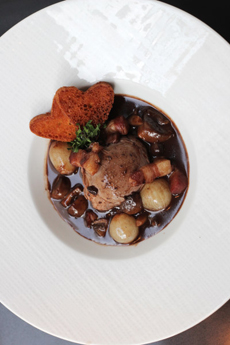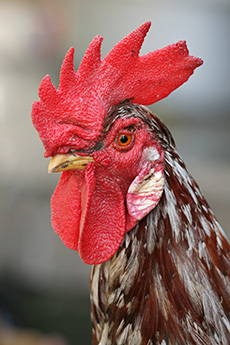RECIPE: Coq Au Vin For National Coq Au Vin Day
|
May 29th is National Coq Au Vin Day (pronounced cuhk-oh-VAN). The name of this French country dish means “rooster with wine [sauce].” The wine varies by local specialty and can be red or white: Burgundy in Burgundy, Riesling in Alsace, and so forth. This classic dish is a bistro favorite, and one of the first French dishes many home cooks learn in the French repertoire. Here’s a recipe. It’s a simpler preparation than the recipe from Chef Antoine Westermann, below. Although the word coq in French means rooster or cock, most modern Coq au Vin recipes call for female chicken. It can be an old chicken: Tough birds with lots of connective tissue become tender meat after a long braise. Older roosters and hens were preferred because more connective tissue creates a richer broth. In earlier days, chickens and roosters past their prime were headed to the braising pan or the stew pot. In the U.S., standard recipes often call for red wine (often Burgundy or “red wine”) for braising, lardons (salt pork or bacon), button mushrooms, onions, perhaps garlic, and sometimes brandy. The usual seasonings are bay leaf, parsley and thyme—usually in the form of a bouquet garni—plus salt and pepper. The pan juices are thickened with a roux. The preparation is similar in many respects to Boeuf Bourguignon. The chicken is seasoned, dusted with flour, then seared in fat and slowly simmered in wine until tender. Anecdotal talk traces Coq au Vin to ancient Gaul and the table of Julius Caesar, but it is generally accepted that the rustic dish existed long before then. All a cook needed was wine and a rooster (both originating around 6000 B.C.E.). However, it seems that the recipe was not documented until the early 20th century. A somewhat similar recipe, poulet au vin blanc ) chicken in white wine, appeared in an 1864 cookbook (source). In recent centuries, Coq au Vin became a specialty in Lyon, a French culinary capital that also gave us: It became a popular dish for entertaining, because much of the preparation is done before guests arrive. Coq au Vin is a braise. Related dishes are sautés and fricassees. In Mastering the Art of French Cooking, Julia Child describes fricassee as “halfway between a sauté and a stew.” A sauté has no liquid added (besides the fat), while a stew includes liquid from the beginning. A braise is first sautéed or seared at a high temperature, then cooked with a liquid or sauce for a longer time, at a lower temperature, in a covered pot. In both Coq au Vin and Chicken (or veal) Fricassee, the meat is first braised. The vegetables are usually carrots and onions or leeks, and they are generally served with dumplings, noodles, rice or roasted potatoes. A fruity red wine is a favored accompaniment to Coq au Vin (Beaujolais, California Syrah, Italian Dolcetto), a white wine for a fricassee. This recipe comes straight from the kitchen of Chef Antoine Westermann, who famously gave back his three Michelin stars to pursue “unfettered culinary creativity.” A lifelong champion of poultry, Chef Westermann perfected the art of cooking fowl at his restaurant Le Coq RicoLe Coq Rico, with locations in Paris and New York City. |
|
|
|
Coq Au Vin, he says, is renowned for its simple ingredients and basic techniques. He serves his Coq au Vin with egg noodles. Ingredients For 4 Servings Total prep and cook time is 1 hour, 55 minutes. 1. PREPARE the marinade: Peel and chop the carrots into pieces, wash and cut the leek into rounds, wash and cut the celery into chunks, peel and cut the onion into rings, and peel and crush the cloves of garlic. 2. PLACE the carrot, leek, celery, onion and garlic in a large bowl. Mix in the clove, thyme, bay leaf and wine. Place the chicken pieces in the marinade, cover, and put in the refrigerator to marinate for 24 hours. After the chicken has marinated… 3. POUR 7 tablespoons of olive oil into a cocotte (that’s French for a Dutch oven). Reserving the marinade, remove the chicken and cook over high heat until golden. 4. PLACE the marinade and vegetables in a pan and bring to a boil. Run through a strainer to clarify the liquid. 5. REMOVE the pieces of chicken from the pan and deglaze the pan with the chicken stock. Season with salt and pepper. 6. ADD the chicken, vegetables from the marinade, and filtered liquid. Cover the pan and cook over low heat for 90 minutes. 7. WASH the mushrooms and cut them into large pieces. Pour 3 tablespoons of olive oil in a pan and brown the mushrooms and bacon. Add salt and pepper. 8. REMOVE the chicken and place it under a sheet of aluminum foil. Add 1 tablespoon of flour to the cooking juices, stirring constantly. Adjust the seasoning. Return the pieces of chicken to the pan, and add the bacon and mushrooms. Cook for a few minutes on low heat. 9. CUT the bread into small cubes. Heat the butter and cook the croutons until golden brown. 10. PLACE the chicken in a baking dish. Distribute the bacon, mushrooms and croutons around the chicken. Evenly drizzle the sauce atop the dish. Reheat for a few minutes, so that the dish is very hot. Serve with egg noodles. In conclusion: Cocorico!, French for cock-a-doodle-doo!
|
||


